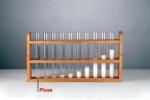General information:
By fixed residue is meant the totality of organic and inorganic substances dissolved in water, stable at a temperature of 105 ± 20C.
Referential after which the analysis is performed:
The analysis for determining the fixed water residue is performed within its own laboratory according to the standards national STAS 3638-76.
Principle of the method:
The determination of the fixed residue to drinking water is performed by drying at the oven.
Sample rejection cases – quantity of inappropriate sample, sample collected in inappropriate containers, samples not properly labelled, etc.
Recipient of harvesting – clean container, the container is filled with whole water avoiding the formation of air bubbles, then close the airtight container.
The amount of sample required to perform the analysis - minimum 200ml.
Processing required after harvesting – not required.
Stable sample – freshly harvested water is stable for 3 hours at ambient temperature.
Analysis method - gravimetrica.
Reference values for drinking water and mineral waters 1)
| Parameter / Unit of measurement | CMA value (Maximum permissible concentration) |
|
| minim 100 mg/l – maximum 800 mg//l |
| exceptionally admitted:minim 30 mg/l – maximum 1200 mg/l |
Recommendations for performing the analysis/ Effects of exceeding the reference values –
The quality of mineral waters (flat or carbonated) depends on the content of the fixed residue, which does not refer to impurities, but to the level of mineral salts. The best are poorly mineralized or flat waters, as they can be consumed indefinitely. Highly mineralized waters should be consumed only on the recommendation of the doctor, as they can cause kidney and biliary problems.
Bibliography:
- LEGEA 458/2002 as amended and supplemented by Law no. 311/2004, Government Ordinance no. 11/2010, Law no. 124/2010 and Government Ordinance no. 1/2011






